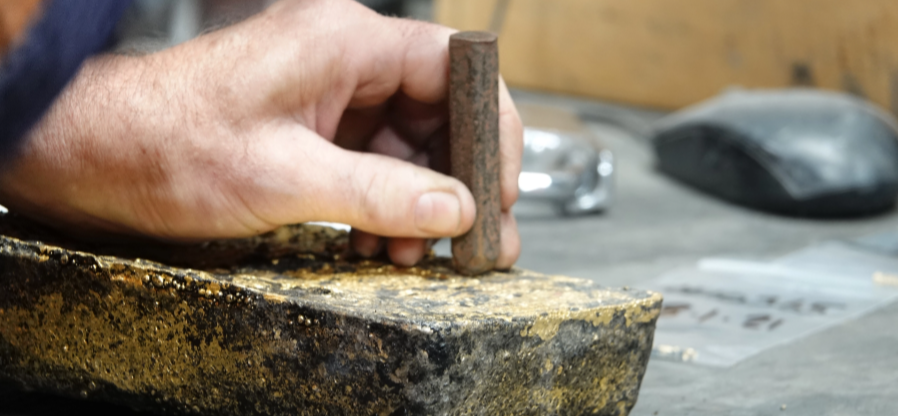
Gold in Otago
Otago is renowned for its gold deposits and the early European history of mining those deposits has played a fundamental role in shaping Otago into the province that we know and love today. 162 years since gold was first discovered at Gabriels Gully in 1861, gold mining continues to be a mainstay of Otago's economic prosperity and looking forward, it appears to have a bright future.
In Otago there are two types of gold deposit: Hard-rock deposits, which are hosted in Otago Schist basement rocks and were formed by geological processes deep within the Earth's crust; and alluvial deposits, gold eroded from hard-rock sources, transported, recycled, and concentrated as gold grains and nuggets in surficial sediments by physical and chemical weathering processes. At Macraes, we are mining a hard-rock gold deposit.
Macraes Geology and Gold
Two hundred million years ago Otago was situated offshore, east of the Gondwana supercontinent. At this time the Otago Schist consisted of an especially thick pile of marine sediments that was being accreted (bulldozed) onto the leading edge of the overriding Gondwanan tectonic plate at a long-lived subduction zone. Compressional tectonics – thrust faulting and folding – over the next c.90 million years caused stacking of the pile, further thickening it, and mountain building. As the pile grew in thickness, sediments at depth were subjected to heat and pressure, minerals recrystallised and formed new minerals (metamorphism), and the pile of marine sediments developed into the Otago Schist as we know it today.
Metamorphism of the sediment released hot water (hydrothermal fluids) into the rock, carrying with it dissolved metals including gold, tungsten, arsenic, and antimony. Hydrothermal fluids rise through the rock via paths of least resistance and faults that crosscut the rock provide particularly efficient paths for fluid migration. Consequently, hydrothermal fluids and dissolved metals from large volumes of sediment became channelled and concentrated into narrow fault/shear structures. Where geochemical conditions were favourable, metals precipitated from the hydrothermal fluids through formation of minerals such as pyrite (FeS2), arsenopyrite (FeAsS), and scheelite (CaWO4), along with voluminous amounts of quartz ± carbonate ± graphite. Gold that precipitated typically formed minute grains enclosed within quartz or, predominantly, the sulphide minerals pyrite and arsenopyrite.
Metal mobilisation and deposition likely occurred from the onset of metamorphism c.200 million years ago but the oldest (and largest) we know of is the Macraes deposit, which formed c.140-130 million years ago. The Macraes deposit is a world-class hard-rock gold deposit endowed with >10 million ounces of gold. It is hosted in a single regional-scale structure known as the Hyde-Macraes Shear Zone (HMSZ), which is up to 150m thick, dips 10-20° to the northeast, and has a lateral strike length of over 40km. The HMSZ developed as a thrust system at c.10km deep and at a temperature of c.300°C, within what is known as the brittle-ductile transition. Two types of hydrothermal fluid, one containing methane and one containing carbon dioxide, slowly migrated along the HMSZ mixing and reacting to deposit abundant hydrothermal graphite – a prominent feature of the HMSZ. The presence of graphite then provided a chemically reducing environment amenable for the precipitation of sulphides (pyrite and arsenopyrite) and gold. Contemporaneously, appreciable scheelite (tungsten carbonate) also precipitated from the migrating hydrothermal fluids into many of the same structures as the gold. Gold deposition in economic quantities did not occur ubiquitously throughout the HMSZ. Instead, gold is concentrated in thicker, higher-grade, plunging shoots that are separated by weakly mineralised sheared rock. These mineralised shoots form what is economic to mine and are the main targets for ongoing exploration.
Shortly after the Macraes deposit formed there was a major shift in tectonic regime: subduction at the East Gondwana margin ceased; compression changed to extension; mountain building changed to mountain collapse; and by c.110 million years ago, the Gondawana supercontinent had begun to breakup into the continents that we know today. This newfound extension stretched the Otago Schist and developed numerous extensional (normal) faults, including some that developed at low angles. These low angle normal faults enabled large slices of rock to slide off the top of the schist belt, rapidly unroofing rocks from deeper in the crust and exposing them at the surface. One of the most prominent of these is the Footwall Fault at Macraes, which truncates the base of the HMSZ and forms the lower limit of economic mineralisation. Elsewhere, some of the steep normal faults that developed provided new pathways for hydrothermal fluids to migrate and enabled a second phase of gold mineralisation to occur (e.g. Nenthorn, Barewood, and Oturehua). These younger gold deposits formed relatively near surface, are typically small, and are usually sub-economic for mining.
Over the next c.40 million years extension and normal faulting continued and the Otago landscape became dominated by river valleys, sedimentary basins, and elevated ranges. Erosion of Otago Schist debris (and gold) into the valleys/basins followed by repeated cycles of uplift, erosion, and recycling of those sediments gave rise to deposits dominated by resistant quartz pebbles, while softer components of the schist were finely ground and washed out to sea. Due to its high-density, gold tended to reside with the gravels but was typically widely dispersed throughout. Only with sufficient recycling of the sediment could the gold grains locally concentrate into alluvial “placer” deposits.
By 60 million years ago New Zealand had fully separated from Australia and due to on-going extension and subsidence, the Otago region began to submerge beneath the sea. The advancing coastline progressively migrated inland, eroded a large low-relief surface (Waipounamu Erosion Surface) and deposited a sequence of marine sediments atop the schist. By 30 – 25 million years ago the marine incursion reached a maximum, sedimentation became minimal (Marshall Paraconformity), and the sea began to retreat. This coincided with the inception of the modern Alpine Fault Australian-Pacific plate boundary through the South Island, and a new phase of compressional tectonism. Initially this new compression caused uplift and crustal thickening centred around the Mt Aspiring area in Northwest Otago; during which a third phase of gold-bearing quartz veins formed within pre-existing steeply dipping structures (e.g. Macetown and Bullendale).
Meanwhile, in East Otago uplift was minor and trans-tensional extensional faulting prevailed, allowing ascension of intra-plate basalt magmatism and eruption of the Waipiata Volcanics between 25 – 9 million years ago. About 6.5 million years ago a shift in plate motion across the Alpine Fault resulted in more-oblique convergence, widespread compression, and accelerated crustal-thickening and uplift, giving us today’s plate tectonic setting. In East Otago over the last c.5 million years, this convergence produced the northwest trending Kakanui, Hawkdun, and St Bathans Ranges; and since c.1 million years ago, the northeast trending ranges that dominate the Central and East Otago landscape (e.g. Rock and Pillar Range, Rough Ridge, Dunstan Range, etc). Since emerging from the sea, rocks of Otago have been subjected to physical and chemical weathering. Over time, where not protected by overlying resistant basalt cap-rocks, the relatively soft stratigraphy was eroded away, bringing the Otago Schist bedrock back to the surface and positioning the world-class multi-million-ounce Macraes gold deposit within the reach of economically sustainable mining.

Gold Delivery
Each gold bar poured at our operation is prepared to be shipped to the Perth Mint in Australia. Here it will be manufactured into a range of products:
![]()


